From Bifocals to Progressives: A Look at Multifocal Glasses
Many individuals rely on glasses to see clearly and improve their vision. However, as individuals age, they may experience a condition called presbyopia, which affects their ability to see objects up close. When this occurs, multifocal glasses become a necessity. In this article, we take a closer look at multifocal glasses, starting with their evolution from bifocals to progressives and the benefits they offer to individuals with presbyopia.
Evolution of Multifocal Glasses: From Bifocals to Progressives
Bifocals, invented by Benjamin Franklin in the late 18th century, were the first multifocal glasses. They featured two distinct areas on the lenses – the upper portion for distance vision and the lower portion for near vision. Bifocals were effective in correcting both presbyopia and long-range vision issues, but they had a noticeable line dividing the different sections of the lens.
As the years passed, lens manufacturers sought to improve the design of multifocal glasses. This led to the development of progressive lenses, also known as no-line bifocals. Progressives provide a seamless transition from distance vision to near vision, eliminating the visible line that bifocals had. Essentially, these lenses offer a gradual change in prescriptions as you look downward, allowing for a more natural visual experience. This innovation has revolutionized the use of multifocal glasses, making them more comfortable and aesthetically appealing.
Benefits of Multifocal Glasses for Individuals with Presbyopia
Multifocal glasses, particularly progressives, offer several advantages for individuals experiencing presbyopia:
1. Convenience: With multifocal glasses, there is no need to switch between different pairs of glasses. Progressives provide a seamless vision correction for both distance and near vision, eliminating the need to carry multiple pairs of glasses.
2. Improved Aesthetics: Progressives, without visible lines, provide a more aesthetically pleasing look compared to traditional bifocals. The absence of a visible lens division allows wearers to enjoy a natural appearance without the tell-tale sign of bifocal lenses.
3. Enhanced Vision at All Distances: Multifocal glasses ensure clear vision at all focal lengths. Whether you need to read a book up close, work on a computer at an intermediate distance, or see objects far away, you will be able to do so without experiencing any visual discomfort.
4. Adaptation: While some users may experience a brief adaptation period when transitioning from single-vision glasses to multifocal glasses, most individuals adjust quickly. After a short time, users find it natural to look through the appropriate part of the lens for specific tasks without conscious effort.
In conclusion, multifocal glasses are a remarkable development in the realm of vision correction. From bifocals to progressives, these glasses have come a long way. Progressives, in particular, offer a more natural visual experience, eliminating the visible lines found in traditional bifocals. For individuals with presbyopia, multifocal glasses provide convenience, improved aesthetics, and enhanced vision at all distances, allowing them to enjoy their daily activities without the hassle of switching between multiple pairs of eyeglasses. With these advancements in multifocal glasses, individuals with presbyopia can continue to experience clear vision and enjoy a comfortable and stylish eyewear solution.
